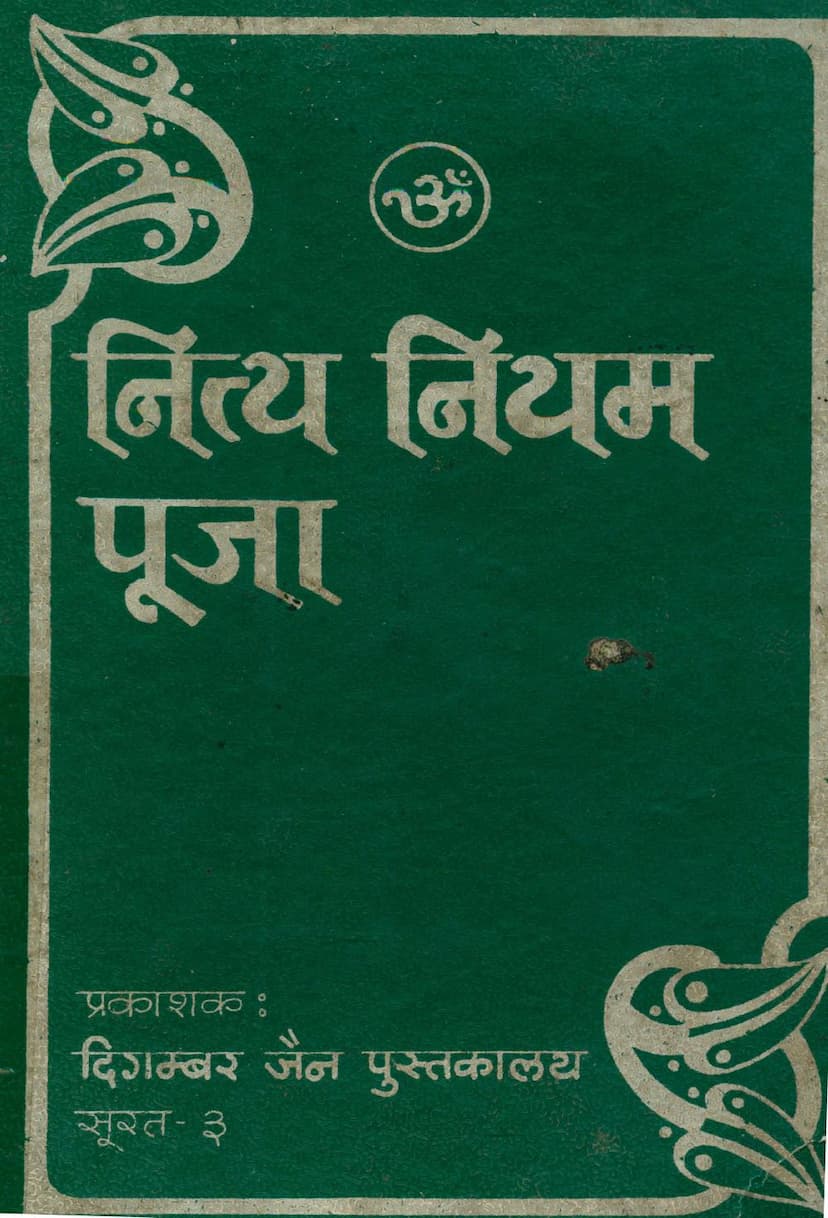Nitya Niyam Puja
Added to library: September 2, 2025

Summary
This document, titled "Nitya Niyam Puja" (Daily Ritual Worship), compiled by Digambar Jain Pustakalay, Surat, is a comprehensive collection of Jain rituals, prayers, and devotional texts intended for daily and festival worship. It serves as a guide for both private and public devotional practices within the Digambar Jain tradition.
The book is organized with a detailed table of contents, covering a wide range of devotional activities:
Key Sections and Content:
- Temple Etiquette and Darshan: It begins with the proper procedures for visiting a temple, including the "Dev Darshan Vidhi" (Method of Seeing the Deity) and "Darshan Path" (Prayer for Seeing the Deity).
- Tirthankara Information: It lists the names of current and future Tirthankaras (spiritual teachers in Jainism).
- Abhishek (Consecration) Rituals: A significant portion is dedicated to various Abhishek rituals, including:
- Panchamrita Abhishek (consecration with five nectars) in Sanskrit and vernacular.
- Laghu Abhishek (short consecration) and Abhishek Path.
- Mantras and verses for purification and consecration, involving offerings of water, sandalwood, rice, flowers, etc.
- Devotion to the Pancha Parameṣṭhi: Prayers and worship dedicated to the five supreme beings in Jainism: Arihants, Siddhas, Acharyas, Upadhyayas, and Sadhus. This includes specific Pujas (worship) and Aratis (devotional songs with lamps).
- Pujas for Specific Deities and Concepts: The book includes Pujas for various occasions and concepts:
- Dev-Shastra-Guru Puja (Worship of Deity, Scripture, and Guru).
- Pujas for the 24 Tirthankaras, including specific Arghya (offering) for each.
- Pujas for important spiritual concepts like Ratnatraya (Three Jewels of Jainism), Dshalakshan Dharma (Ten Virtues), and Sixteen Karan (Sixteen Causes for attaining purity).
- Pujas for specific Tirthankaras like Adinath, Shantinath, Parshvanath, and Mahavir.
- Pujas for overcoming obstacles (Vighnaharta) and for specific auspicious occasions like Raksha Bandhan and Saluna festival.
- Pujas for Navagraha (Nine Planets) for averting ill effects.
- Pujas dedicated to specific revered figures like Padmavati Mata.
- Siddha Puja: Detailed rituals for worshipping the Siddhas (liberated souls), including Dravyashtaka (eight material offerings) and Bhavashtaka (eight spiritual offerings).
- Chaitralaya (Temple) Pujas: Worship of both artificial (Kritrim) and natural (Akritrim) temples.
- Mantras and Shanti Path: Inclusion of various mantras for peace and well-being, including Laghu and Brihat Shanti Mantras (short and long peace chants).
- Stotras and Bhajans: Devotional hymns and songs in praise of the Tirthankaras and other deities.
- Other Important Texts: The book also includes portions of significant Jain scriptures like the Bhaktamara Stotra and Tattvartha Sutra, along with the Barah Bhavna (Twelve Reflections).
- Special Pujas: Specific pujas for festivals like Nandiśvara Dvipa (Ashtahnika), Dashalakshan Dharma, and Ravivrata are included.
- Language and Accessibility: While some Sanskrit texts are present (like the Panchamrita Abhishek Path), the book primarily uses Hindi for its devotional songs and descriptions, making it accessible to a wider audience.
Publisher Information:
The book is published by Digambar Jain Pustakalay, Gandhi Chowk, Surat-3. It also mentions the printer, Shailesh Dhahyabhai Kapadia of "Jain Vijay Printing Press." The catalog link provided points to jainqq.org, suggesting it is part of a larger collection of Jain literature.
Overall Purpose:
"Nitya Niyam Puja" aims to provide a structured and comprehensive resource for Jains to perform their daily worship and observe religious festivals. It covers a vast array of devotional practices, ensuring that individuals have access to the necessary prayers, rituals, and guidance for a fulfilling spiritual life according to Digambar Jain principles. The inclusion of various saints' compositions and the focus on accessible language highlights its practical utility for devotees.